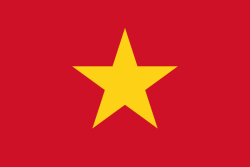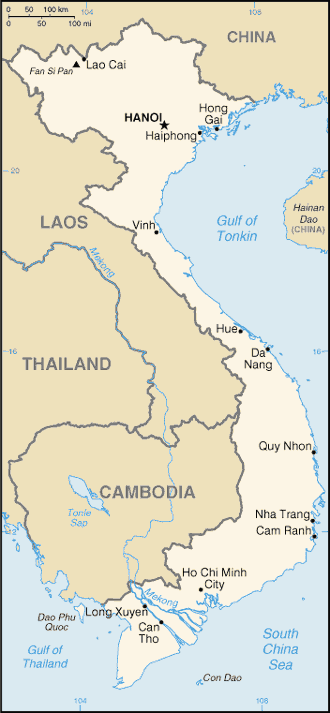Socialist Republic of Vietnam
Related Categories:
 Flag of Vietnam
Flag of VietnamRed with a large yellow five-pointed star in the center. |
 Traditional Symbols of Vietnam
Traditional Symbols of VietnamThe traditional Coat of Arms consisted of a shield or banner or varied forms, having the stylistic representation of a dragon, a legendary and totemic animal of multiple symbolic significance.
www.vietventures.com/
The Viet Nam Flag, Coat of Arms, 1945-1955 flag, Flag Tower of Hanoi, Flag Tower of Hué, Roundel, Unidentified nautical flag.
www.fotw.us/
The country is listed among the "Next Eleven" economies; according to government figures, GDP growth was 8.17% in 2006, the second fastest growth rate among countries in East Asia and the fastest in Southeast Asia.
en.wikipedia.org/
Originating in what is now southern China and northern Vietnam, the Vietnamese people pushed southward over 2 millennia to occupy the entire eastern seacoast of the Indochinese Peninsula. Ethnic Vietnamese constitute about 90% of Vietnam's population.
Vietnam's approximately 2.3 million ethnic Chinese, concentrated mostly in southern Vietnam, constitute Vietnam's largest minority group. Long important in the Vietnamese economy, Vietnamese of Chinese ancestry have been active in rice trading, milling, real estate, and banking in the south and shop keeping, stevedoring, and mining in the north. Restrictions on economic activity following reunification of the north and south in 1975 and the subsequent but unrelated general deterioration in Vietnamese-Chinese relations sent chills through the Chinese-Vietnamese community. In 1978-79, some 450,000 ethnic Chinese left Vietnam by boat as refugees (many officially encouraged and assisted) or were expelled across the land border with China.
The second-largest ethnic minority grouping, the central highland peoples (formerly termed Montagnards or mountain people), comprise two main ethnolinguistic groups--Malayo-Polynesian and Mon-Khmer. About 30 groups of various cultures and dialects are spread over the highland territory.
The third-largest minority, the Khmer Krom (Cambodians), numbering about 600,000, is concentrated near the Cambodian border and at the mouth of the Mekong River. Most are farmers. Other minority groups include the Cham--remnants of the once-mighty Champa Kingdom, conquered by the Vietnamese in the 15th century--Hmong, and Thai.
Vietnamese is the official language of the country. It is a tonal language with influences from Thai, Khmer, and Chinese. Since the early 20th century, the Vietnamese have used a Romanized script introduced by the French. Previously, Chinese characters and an indigenous phonetic script were both used.
www.state.gov/r/
Introduction
About
Contact
Symbols in The News
Interpret this Symbol
AAC
African
AI
Alchemy
Alphabets
Ancient
Animal Symbolism
Architecture
Art
Articles
Astrology
Baha'i
Blissymbolics
Blueprint Symbols
Buddhist
Celtic Symbols
Cemetery
Chinese Symbols
Christian
Circle
City
Codes
Color
Conlangs
Crop Circles
Danger
Da Vinci Code
Designing Logos
Dictionaries
Dreams
Education
Egyptian Symbols
Electrical
Emoticons
Find Images
Fonts
Food
Fraternity
Hamsa
Healing
Heraldry
Hermetic
Highway Signs
Hindu
History
Hobo
Holiday
Icons
iConji
Islamic
Jain Symbols
Japanese, Kanji
Jewish
Justice
Law
Literary Symbolism
Mandalas
Map
Masonic
Math, Number
Meaning of Names
Medical
Middle East
Military
Miscellaneous
Money
Music
Mythology
Native American
Playing Cards
Power
Psychology
QiQiiKhu
Reiki
Religious
Runes, Norse
Sacred Geometry
Scientific
Science Fiction
Sorority
Sports
Symbols in the News
Tattoos
ThirteenSymbols
Tree of Life
Ursprache
Videos
Visual Languages
Weather
Web Codes
Wicca
Words
Writing Systems
Braille
Coinherence
Coptic
Cuneiform
Easter Island
Etruscan
Happy Human
Hebrew
Kokopelli
Linear B
Lotus
Love Symbols
Mandorla
Moon Alphabet
Nine Pointed Star
Om
Oz
Phonetic
Scarab Beetle
Silent
Theosophy
Unifon
About
Contact
Symbols in The News
Interpret this Symbol
AAC
African
AI
Alchemy
Alphabets
Ancient
Animal Symbolism
Architecture
Art
Articles
Astrology
Baha'i
Blissymbolics
Blueprint Symbols
Buddhist
Celtic Symbols
Cemetery
Chinese Symbols
Christian
Circle
City
Codes
Color
Conlangs
Crop Circles
Danger
Da Vinci Code
Designing Logos
Dictionaries
Dreams
Education
Egyptian Symbols
Electrical
Emoticons
Find Images
Fonts
Food
Fraternity
Hamsa
Healing
Heraldry
Hermetic
Highway Signs
Hindu
History
Hobo
Holiday
Icons
iConji
Islamic
Jain Symbols
Japanese, Kanji
Jewish
Justice
Law
Literary Symbolism
Mandalas
Map
Masonic
Math, Number
Meaning of Names
Medical
Middle East
Military
Miscellaneous
Money
Music
Mythology
Native American
Playing Cards
Power
Psychology
QiQiiKhu
Reiki
Religious
Runes, Norse
Sacred Geometry
Scientific
Science Fiction
Sorority
Sports
Symbols in the News
Tattoos
ThirteenSymbols
Tree of Life
Ursprache
Videos
Visual Languages
Weather
Web Codes
Wicca
Words
Writing Systems
Braille
Coinherence
Coptic
Cuneiform
Easter Island
Etruscan
Happy Human
Hebrew
Kokopelli
Linear B
Lotus
Love Symbols
Mandorla
Moon Alphabet
Nine Pointed Star
Om
Oz
Phonetic
Scarab Beetle
Silent
Theosophy
Unifon
